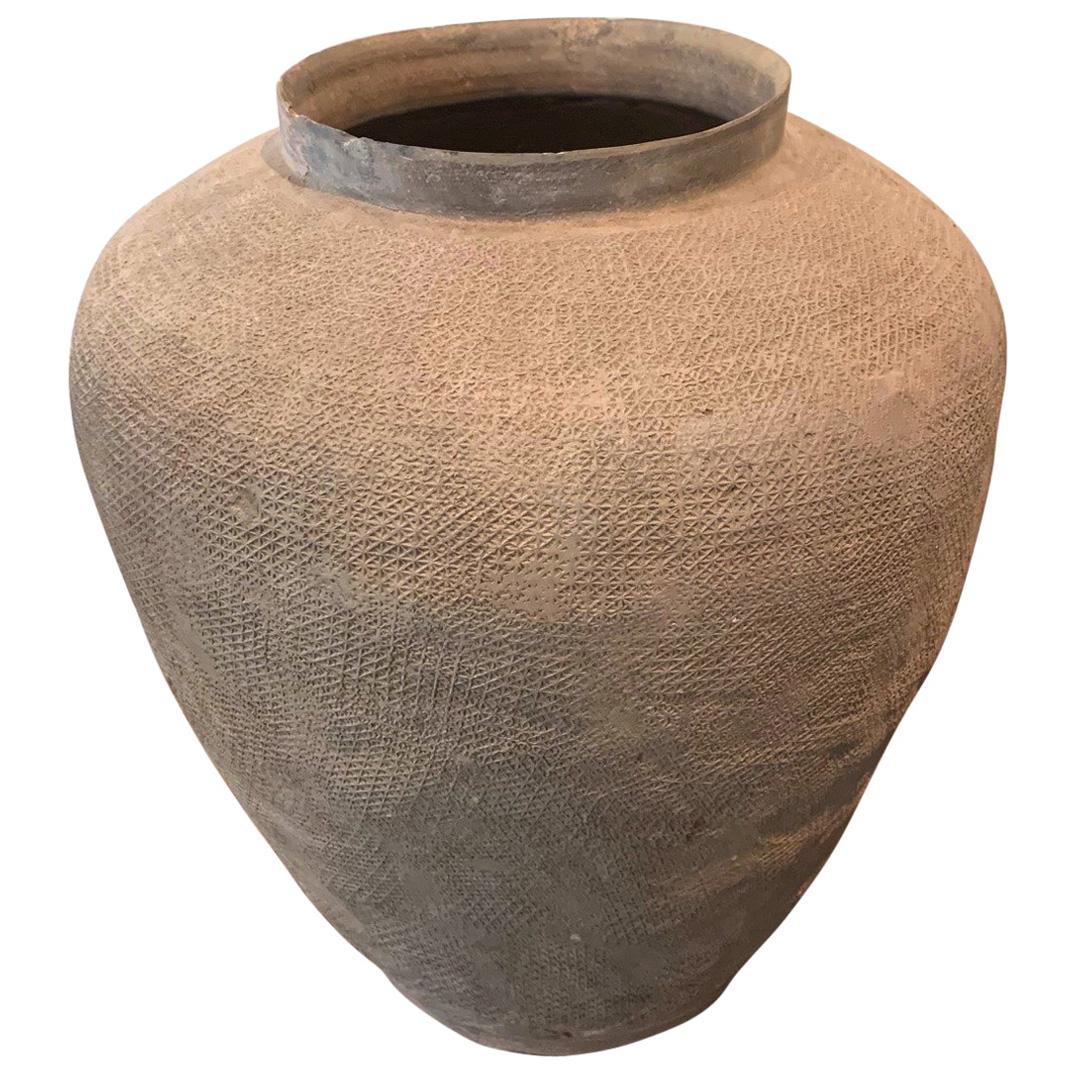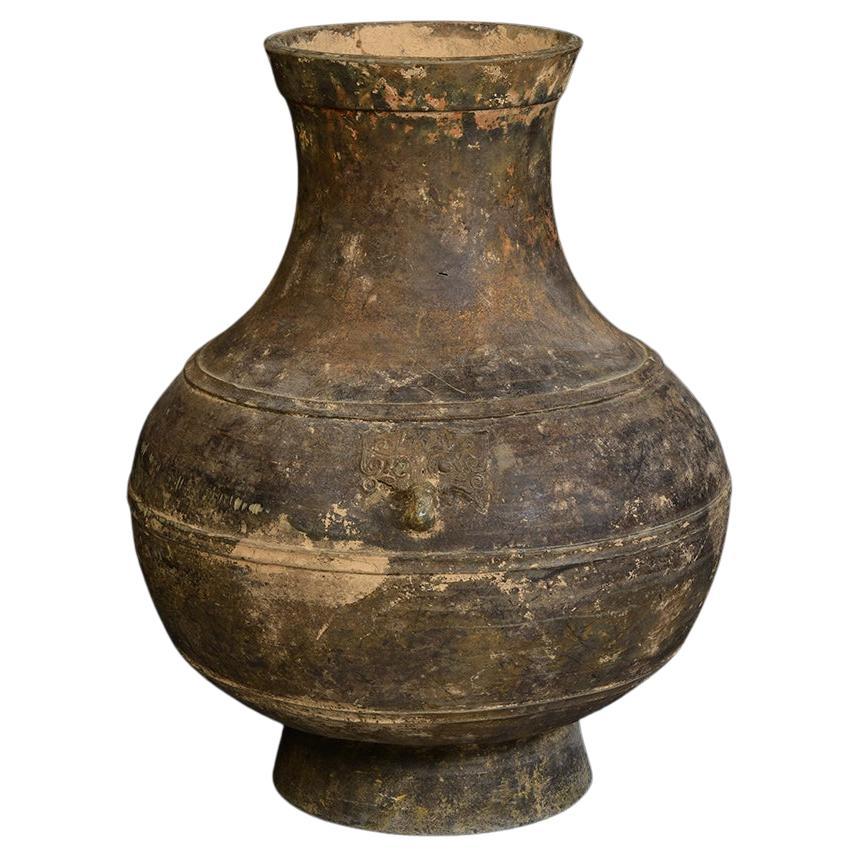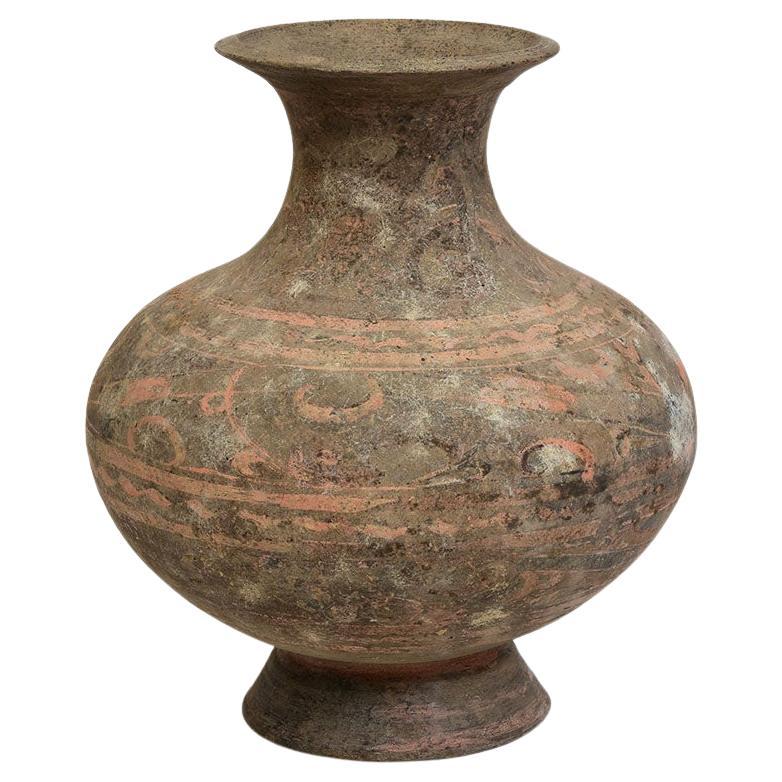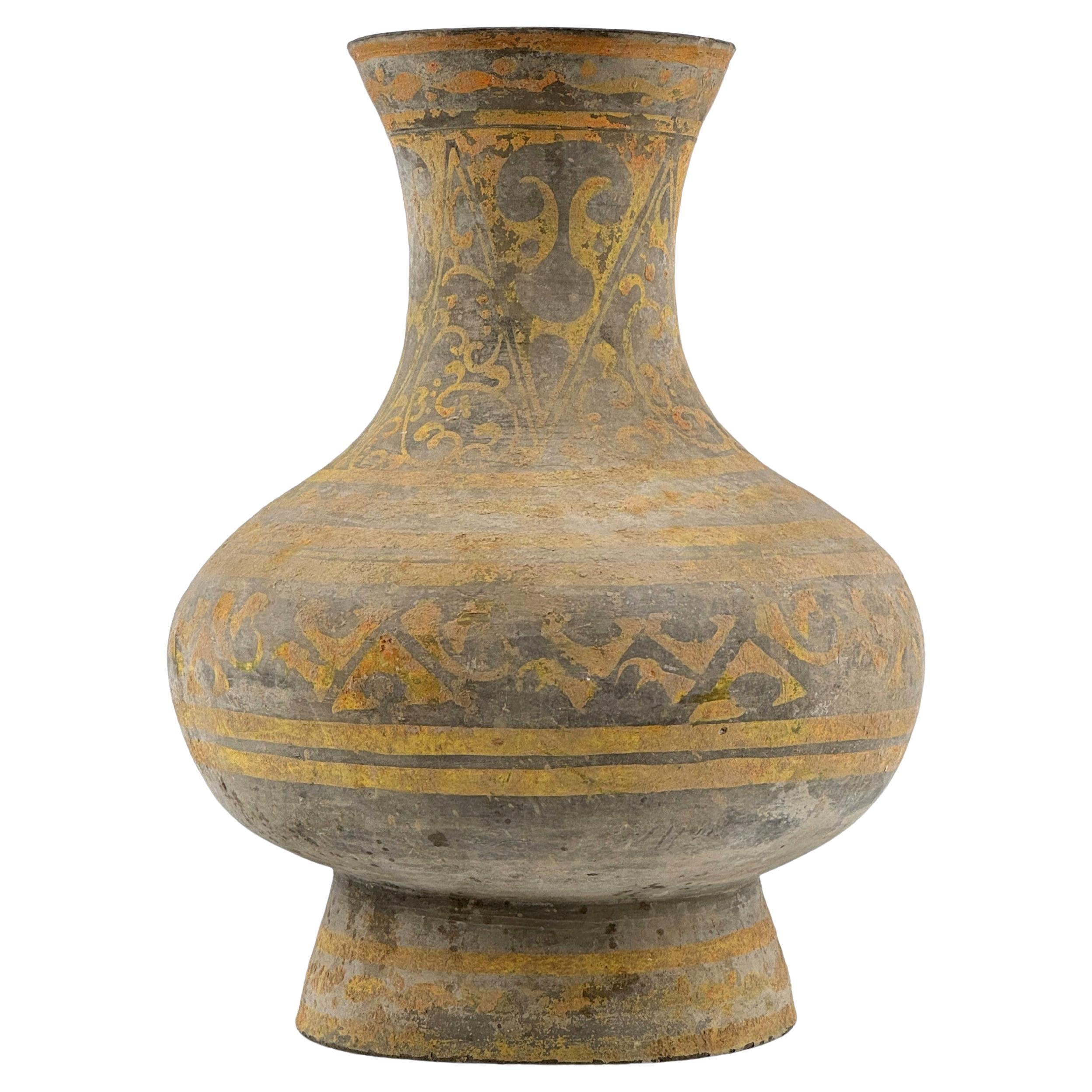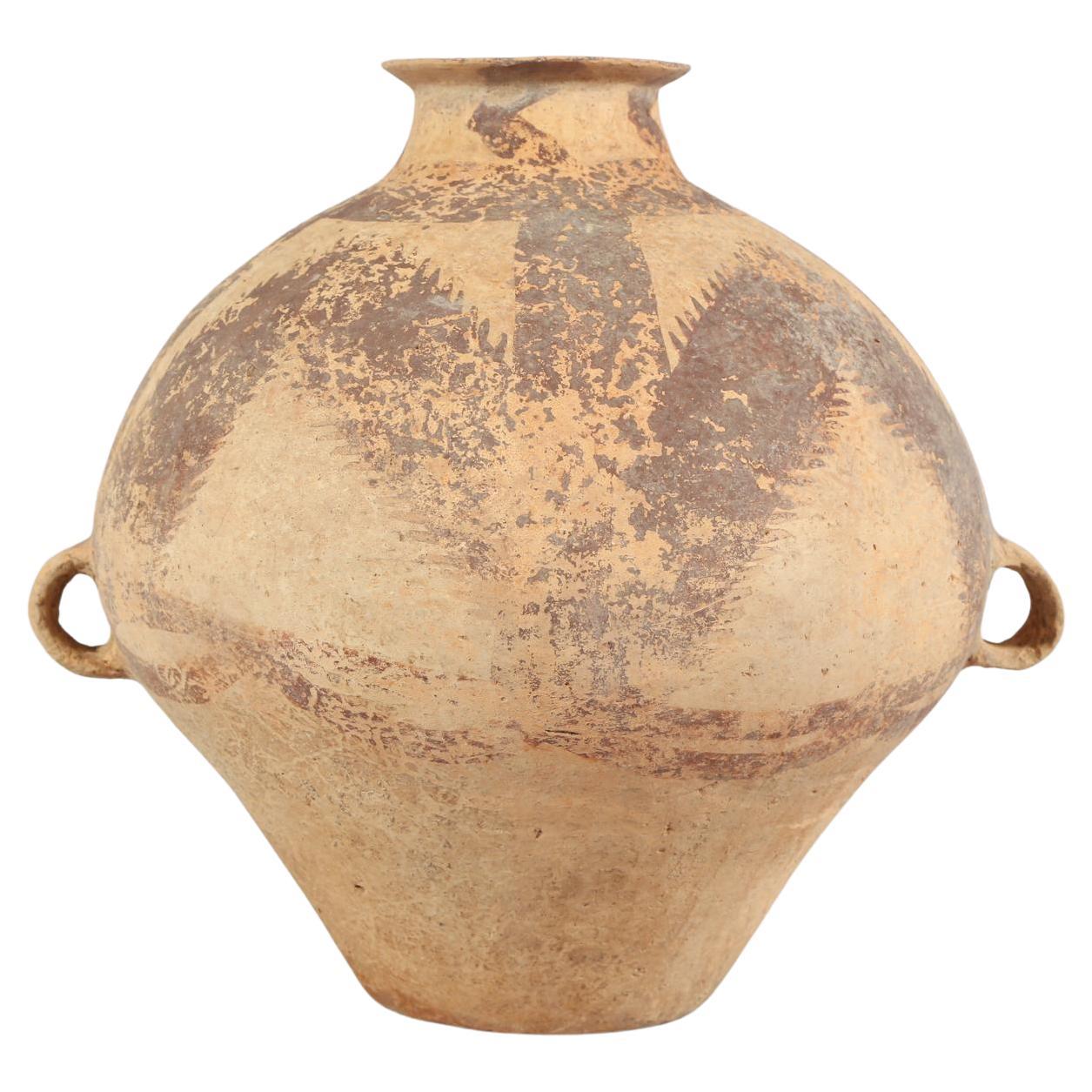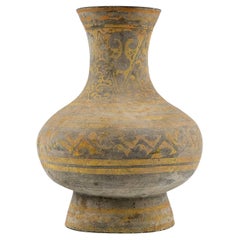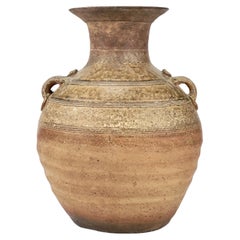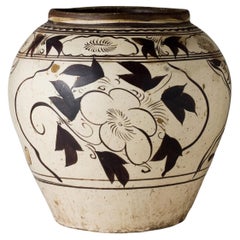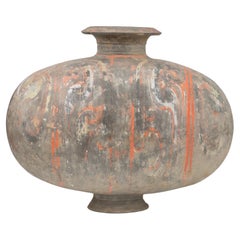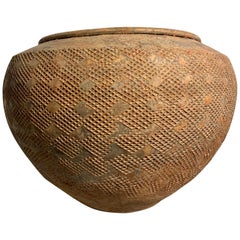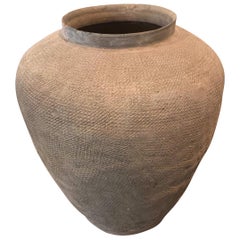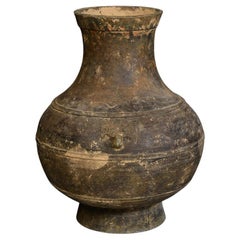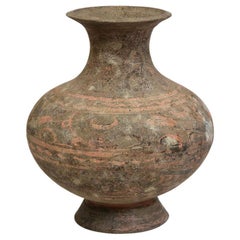Items Similar to Large Yue Globular Stoneware Jar, Han Dynasty-Three Kingdoms
Want more images or videos?
Request additional images or videos from the seller
1 of 19
Large Yue Globular Stoneware Jar, Han Dynasty-Three Kingdoms
$2,793
$3,99030% Off
£2,119.26
£3,027.5230% Off
€2,423.19
€3,461.7030% Off
CA$3,901.06
CA$5,572.9530% Off
A$4,337.45
A$6,196.3630% Off
CHF 2,264.78
CHF 3,235.4030% Off
MX$52,797.35
MX$75,424.7930% Off
NOK 28,897.58
NOK 41,282.2630% Off
SEK 27,075.65
SEK 38,679.5130% Off
DKK 18,084.71
DKK 25,835.2930% Off
Shipping
Retrieving quote...The 1stDibs Promise:
Authenticity Guarantee,
Money-Back Guarantee,
24-Hour Cancellation
About the Item
Robustly crafted with a voluminous spherical body and a layered mouth rim, this jar features a pair of taotie handles. It is adorned with three horizontal bands on the upper half of the olive-green-glazed body, which segment the glazed area into three distinct parts. The top section boasts an incised wave pattern, while the unglazed lower body presents a light brown hue.
Period : Han Dynasty (206 BC - 280 AD)
Type : Jar
Medium : Stoneware
Dimension : 31cm(Height) x 11cm(Mouth Diameter) x 32cm(Diameter)
Provenance : The piece was acquired in Hong Kong in the late 1990s.
Condition : Excellent (Wear consistent with age)
Reference :
1) MIA - Accession Number 98.214.2
(Type : Highly related)
2) Christie's New York 20 MAR 2015 The Collection of Robert Hatfield Ellsworth Part IV - Lot 779
(Price realised : 6,000 USD / Type : Closely related)
3) The MET - Accession Number: 17.154 - Jar
(Type : Closely related)
* Han Dynasty Pottery
Han Dynasty pottery, originating from one of China's most significant historical periods (202 BCE – 220 CE), is renowned for its technological and artistic achievements in ceramic production. These artifacts typically feature a distinctive green glaze, although other colors were also used. The pottery often includes intricate decorative motifs, such as animals, mythological figures, and geometric patterns.
The craftsmanship during the Han Dynasty was advanced, with pottery techniques that were innovative for the time. These pieces were not only utilitarian but also held ceremonial and symbolic significance. The shapes and designs of Han Dynasty pottery vary, including items like urns, vases, and figures, reflecting both the daily life and the spiritual beliefs of the period.
About the Seller
4.8
Gold Seller
Premium sellers maintaining a 4.3+ rating and 24-hour response times
Established in 1999
1stDibs seller since 2023
38 sales on 1stDibs
Typical response time: <1 hour
- ShippingRetrieving quote...Shipping from: seoul, Korea South
- Return Policy
Authenticity Guarantee
In the unlikely event there’s an issue with an item’s authenticity, contact us within 1 year for a full refund. DetailsMoney-Back Guarantee
If your item is not as described, is damaged in transit, or does not arrive, contact us within 7 days for a full refund. Details24-Hour Cancellation
You have a 24-hour grace period in which to reconsider your purchase, with no questions asked.Vetted Professional Sellers
Our world-class sellers must adhere to strict standards for service and quality, maintaining the integrity of our listings.Price-Match Guarantee
If you find that a seller listed the same item for a lower price elsewhere, we’ll match it.Trusted Global Delivery
Our best-in-class carrier network provides specialized shipping options worldwide, including custom delivery.More From This Seller
View AllEarthenware Pottery Jar, Han Dynasty(206 BC-220 AD)
Located in seoul, KR
This jar would have served as a mortuary object (mingqi), placed in a tomb as a substitute for the more valuable bronze and lacquer vessels. Along with a variety of other funerary earthenware objects, attendant figures, and animals, richly decorated vessels of this kind were intended to serve the spirit of the deceased in the afterlife.
Period : Han dynasty
Type : Jar
Medium : Earthenware
Dimension : 28.5 cm(Height) x 11cm(Mouth Diameter)
Condition : Good(Overall in well-preserved ancient burial condition with some soil still adhering (showing minor abrasions and wear due to prolonged burial underground)
Provenance : Acquired in late 1990s from Hongkong
* Han Dynasty Earthenware...
Category
Antique 15th Century and Earlier Hong Kong Han Antiquities
Materials
Earthenware
$2,093 Sale Price
30% Off
A Green-Glazed Stoneware Jar (Hu Vessel), Han Dynasty
Located in seoul, KR
Ovoid form escalating to a cylindrical neck with a flaring rim, adorned at the shoulder with three narrow grooved horizontal bands. Each side is equipped with an incised double-loop ...
Category
Antique 15th Century and Earlier Hong Kong Han Antiquities
Materials
Stoneware
$2,793 Sale Price
30% Off
Large Cizhou Jar, Yuan Dynasty
Located in seoul, KR
This vase is sturdily potted with a robust ovoid body that rises from a short, spreading foot to a gently tapering neck, finishing with a lipped mouth rim. The exterior is decorated ...
Category
Antique 15th Century and Earlier Hong Kong Antiquities
Materials
Pottery
$4,495 Sale Price
50% Off
Large Cocoon-shaped jar with cloud-scroll design, Han Dynasty
Located in seoul, KR
This jar would have served as a mortuary object (mingqi), placed in a tomb as a substitute for the more valuable bronze and lacquer vessels used in daily life. Along with a variety o...
Category
Antique 15th Century and Earlier Hong Kong Han Antiquities
Materials
Pottery
$1,813 Sale Price
30% Off
Neolithic Pottery Amphora(Gansu Province), 3rd-2nd Millenium BC
Located in seoul, KR
Neolithic Vase with raised neck, slightly flared, two handles. Geometric designs and stylized bovine heads in black. Acquired in Hong Kong in the late 1990s.
Date : 3,000-2,000 BC
M...
Category
Antique 15th Century and Earlier Hong Kong Antiquities
Materials
Earthenware, Pottery
$2,600 Sale Price
35% Off
A Rare Sancai-Glazed Pottery Jar, Tang Dynasty
Located in seoul, KR
The jar is of globular shape and is decorated to the body with a geometric design band of lozenge-shaped motifs in blue, green, ochre and cream below a plain ochre everted mouth rim,...
Category
Antique 15th Century and Earlier Hong Kong Tang Antiquities
Materials
Earthenware
$7,950 Sale Price
50% Off
You May Also Like
Massive Chinese Eastern Han Dynasty Impressed Pottery Jar '25-220 AD'
Located in Austin, TX
A stunning and massive Chinese high fired gray pottery jar of remarkable size and girth, with impressed geometric design, Eastern Han Dynasty (25-220 AD), ...
Category
Antique 15th Century and Earlier Chinese Han Antiquities
Materials
Pottery
Stoneware Storage Jar China East Zhou Dynasty
Located in Atlanta, GA
A pinkish stoneware jar with broad shoulder and slightly tapered body from Chinese East Zhou Dynasty (771-256BC). The surface of the jar was nearly thorou...
Category
Antique 15th Century and Earlier Chinese Archaistic Ceramics
Materials
Stoneware
Han Dynasty, Antique Chinese Pottery Hu Jar
Located in Sampantawong, TH
Chinese pottery Hu jar decorated with bands of raised lines and a pair of monster masks on the shoulder.
Age: China, Han Dynasty, 206 B.C. - A.D.220
Size: h...
Category
Antique 15th Century and Earlier Chinese Antiquities
Materials
Pottery
$2,800 Sale Price
20% Off
Han Dynasty, Antique Chinese Painted Pottery Jar
Located in Sampantawong, TH
Antique Chinese painted pottery jar.
Age: China, Han Dynasty, 206 B.C. - A.D.220
Size: Height 28.3 C.M. / Width 25.5 C.M.
Condition: Well-preserved old burial condition overall with...
Category
Antique 15th Century and Earlier Chinese Antiquities
Materials
Pottery
Chinese Neolithic Painted Pottery Jar, Machang Period #4
Located in Bradenton, FL
Chinese Neolithic Pottery Jar from the Majiayao Culture, specifically the Machang phase, in northwest China, and dating back roughly 4000 yea...
Category
Antique 15th Century and Earlier Chinese Other Jars
Materials
Pottery
Chinese Han Dynasty Stoneware Storage Vessel
Located in Astoria, NY
Chinese Han Dynasty Stoneware Storage Vessel, with two applied animal form handles. 10" H x 12.5" Diameter. Provenance: From the Upper East Side Apartment of a Former Ambassador.
Category
Antique 15th Century and Earlier Ceramics
Materials
Stoneware
More Ways To Browse
Antique Kingdom
Asian Brown Jars
Large Asian Jars
Dynasty Jar Glazed
Antique Olive Jar
Pottery Bc
Antique Stoneware Jars
Large Chinese Urn
Chinese Green Glazed Animal
Segmented Vase
Large Glazed Ceramic Urn
Chinese 20 Century Vase
Chinese Stoneware Jar
Chinese 3 Piece Vases
Olive Urn
Han Dynasty Vase
Large Asian Urns
Large Olive Jars

